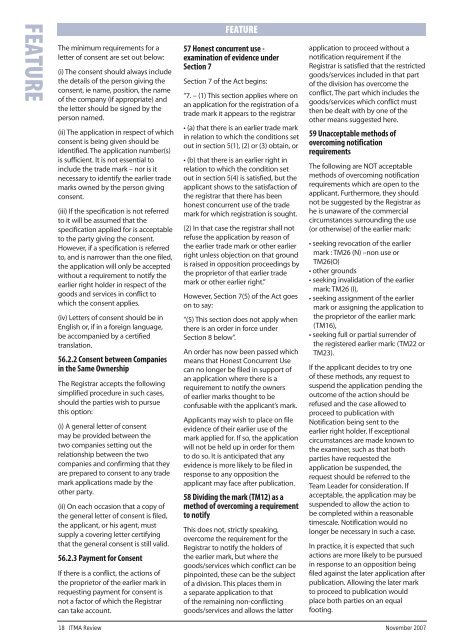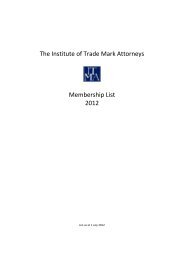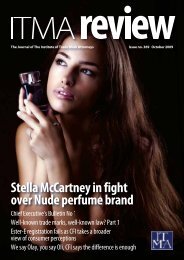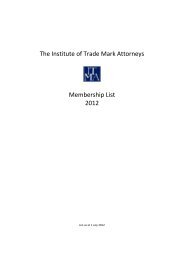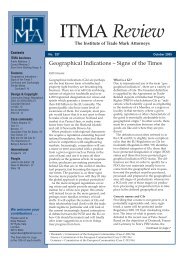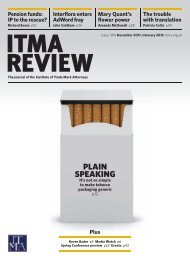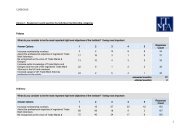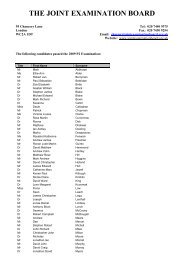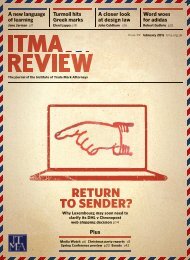ITMA Autumn Conference: Treviso provides cultured backdrop for ...
ITMA Autumn Conference: Treviso provides cultured backdrop for ...
ITMA Autumn Conference: Treviso provides cultured backdrop for ...
You also want an ePaper? Increase the reach of your titles
YUMPU automatically turns print PDFs into web optimized ePapers that Google loves.
FEATURE<br />
The minimum requirements <strong>for</strong> a<br />
letter of consent are set out below:<br />
(i) The consent should always include<br />
the details of the person giving the<br />
consent, ie name, position, the name<br />
of the company (if appropriate) and<br />
the letter should be signed by the<br />
person named.<br />
(ii) The application in respect of which<br />
consent is being given should be<br />
identified. The application number(s)<br />
is sufficient. It is not essential to<br />
include the trade mark – nor is it<br />
necessary to identify the earlier trade<br />
marks owned by the person giving<br />
consent.<br />
(iii) If the specification is not referred<br />
to it will be assumed that the<br />
specification applied <strong>for</strong> is acceptable<br />
to the party giving the consent.<br />
However, if a specification is referred<br />
to, and is narrower than the one filed,<br />
the application will only be accepted<br />
without a requirement to notify the<br />
earlier right holder in respect of the<br />
goods and services in conflict to<br />
which the consent applies.<br />
(iv) Letters of consent should be in<br />
English or, if in a <strong>for</strong>eign language,<br />
be accompanied by a certified<br />
translation.<br />
56.2.2 Consent between Companies<br />
in the Same Ownership<br />
The Registrar accepts the following<br />
simplified procedure in such cases,<br />
should the parties wish to pursue<br />
this option:<br />
(i) A general letter of consent<br />
may be provided between the<br />
two companies setting out the<br />
relationship between the two<br />
companies and confirming that they<br />
are prepared to consent to any trade<br />
mark applications made by the<br />
other party.<br />
(ii) On each occasion that a copy of<br />
the general letter of consent is filed,<br />
the applicant, or his agent, must<br />
supply a covering letter certifying<br />
that the general consent is still valid.<br />
56.2.3 Payment <strong>for</strong> Consent<br />
If there is a conflict, the actions of<br />
the proprietor of the earlier mark in<br />
requesting payment <strong>for</strong> consent is<br />
not a factor of which the Registrar<br />
can take account.<br />
FEATURE<br />
57 Honest concurrent use -<br />
examination of evidence under<br />
Section 7<br />
Section 7 of the Act begins:<br />
“7. – (1) This section applies where on<br />
an application <strong>for</strong> the registration of a<br />
trade mark it appears to the registrar<br />
(a) that there is an earlier trade mark<br />
in relation to which the conditions set<br />
out in section 5(1), (2) or (3) obtain, or<br />
(b) that there is an earlier right in<br />
relation to which the condition set<br />
out in section 5(4) is satisfied, but the<br />
applicant shows to the satisfaction of<br />
the registrar that there has been<br />
honest concurrent use of the trade<br />
mark <strong>for</strong> which registration is sought.<br />
(2) In that case the registrar shall not<br />
refuse the application by reason of<br />
the earlier trade mark or other earlier<br />
right unless objection on that ground<br />
is raised in opposition proceedings by<br />
the proprietor of that earlier trade<br />
mark or other earlier right.”<br />
However, Section 7(5) of the Act goes<br />
on to say:<br />
“(5) This section does not apply when<br />
there is an order in <strong>for</strong>ce under<br />
Section 8 below”.<br />
An order has now been passed which<br />
means that Honest Concurrent Use<br />
can no longer be filed in support of<br />
an application where there is a<br />
requirement to notify the owners<br />
of earlier marks thought to be<br />
confusable with the applicant’s mark.<br />
Applicants may wish to place on file<br />
evidence of their earlier use of the<br />
mark applied <strong>for</strong>. If so, the application<br />
will not be held up in order <strong>for</strong> them<br />
to do so. It is anticipated that any<br />
evidence is more likely to be filed in<br />
response to any opposition the<br />
applicant may face after publication.<br />
58 Dividing the mark (TM12) as a<br />
method of overcoming a requirement<br />
to notify<br />
This does not, strictly speaking,<br />
overcome the requirement <strong>for</strong> the<br />
Registrar to notify the holders of<br />
the earlier mark, but where the<br />
goods/services which conflict can be<br />
pinpointed, these can be the subject<br />
of a division. This places them in<br />
a separate application to that<br />
of the remaining non-conflicting<br />
goods/services and allows the latter<br />
application to proceed without a<br />
notification requirement if the<br />
Registrar is satisfied that the restricted<br />
goods/services included in that part<br />
of the division has overcome the<br />
conflict. The part which includes the<br />
goods/services which conflict must<br />
then be dealt with by one of the<br />
other means suggested here.<br />
59 Unacceptable methods of<br />
overcoming notification<br />
requirements<br />
The following are NOT acceptable<br />
methods of overcoming notification<br />
requirements which are open to the<br />
applicant. Furthermore, they should<br />
not be suggested by the Registrar as<br />
he is unaware of the commercial<br />
circumstances surrounding the use<br />
(or otherwise) of the earlier mark:<br />
seeking revocation of the earlier<br />
mark : TM26 (N) –non use or<br />
TM26(O)<br />
other grounds<br />
seeking invalidation of the earlier<br />
mark: TM26 (I),<br />
seeking assignment of the earlier<br />
mark or assigning the application to<br />
the proprietor of the earlier mark:<br />
(TM16),<br />
seeking full or partial surrender of<br />
the registered earlier mark: (TM22 or<br />
TM23).<br />
If the applicant decides to try one<br />
of these methods, any request to<br />
suspend the application pending the<br />
outcome of the action should be<br />
refused and the case allowed to<br />
proceed to publication with<br />
Notification being sent to the<br />
earlier right holder. If exceptional<br />
circumstances are made known to<br />
the examiner, such as that both<br />
parties have requested the<br />
application be suspended, the<br />
request should be referred to the<br />
Team Leader <strong>for</strong> consideration. If<br />
acceptable, the application may be<br />
suspended to allow the action to<br />
be completed within a reasonable<br />
timescale. Notification would no<br />
longer be necessary in such a case.<br />
In practice, it is expected that such<br />
actions are more likely to be pursued<br />
in response to an opposition being<br />
filed against the later application after<br />
publication. Allowing the later mark<br />
to proceed to publication would<br />
place both parties on an equal<br />
footing.<br />
18 <strong>ITMA</strong> Review November 2007


